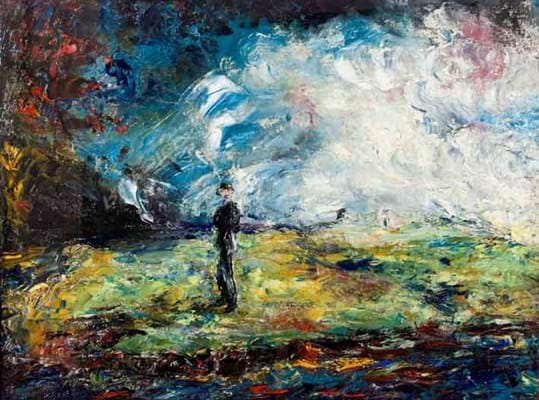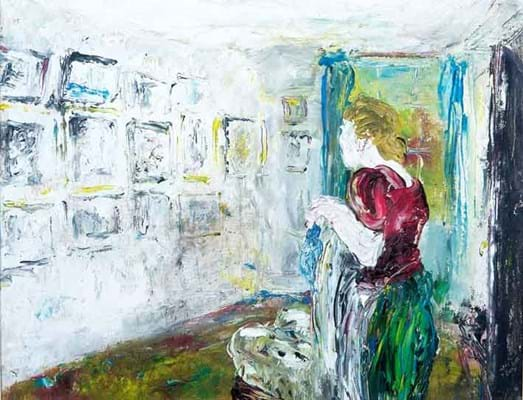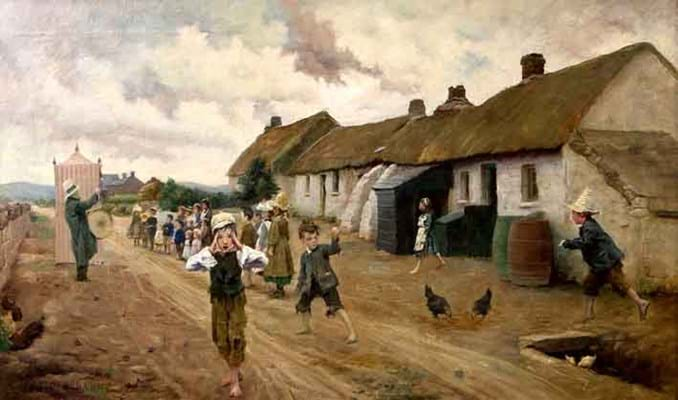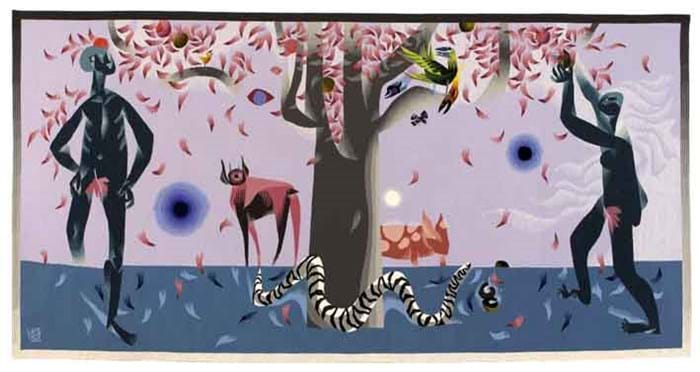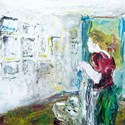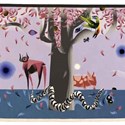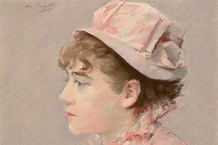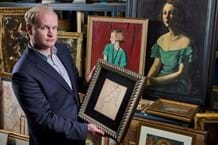In general terms, demand for top works by these artists has held up enough to keep things afloat during the downturn, although whether or not the marginal improvement in market conditions over the course of 2012 helped persuade vendors to consign here is uncertain.
The art market in Ireland is often said to follow the fortunes of the property market. Although both sectors still remain far short of the heady days of the Celtic Tiger boom, the Irish property market is steadily recovering since prices fell by over 50% in 2008 and now the art market has mostly stabilised since reaching rock bottom around two or three years ago.
The current series, however, had two added concerns entering the mix. First was the looming 'mansion tax' announced in the Irish government's December budget. Those with property valued at over €1m will soon have to pay a 0.25% levy on its value.
Although this will undoubtedly take a certain amount of money out of the pockets of wealthy buyers, Irish auctioneers generally felt it was not serious enough to have a damaging a knock-on effect on the art market.
One auctioneer even suggested to ATG that a potential bidder living in a reasonably expensive property (if not quite a 'mansion') might consider investing their resources in furnishing the property with a 'bankable' picture rather than build, for example, an extension or conservatory which would add to their tax liability.
Over Supply
The second issue borne out in the current sales was the question of the over supply of works by certain artists.
Buyers of Irish pictures have become an increasingly selective group and over the last two months there have been a lot of works by the likes of Jack Yeats and Paul Henry for them to choose from - both at salerooms in the UK as well as across the Irish Sea.
After their most recent auctions, each of the Dublin salerooms said that finding fresh material and pitching at the correct levels was therefore essential.
They also noted that the market was becoming a bit more active thanks to both the appearance of some new players as well as the return of a few older faces.
No artist is bigger in the Irish art market than Jack Butler Yeats (1871-1957) and this season saw a fair number of works spread around the different houses. A good Yeats is still one of those 'bankable pictures' and this was proven here again, even though there were probably more works on offer by the artist than the market could absorb in a single series.
Distinctive Yeats
The pick of the Yeats consignments on this occasion came at de Veres (19.5% buyer's premium), who offered five works by the painter at their Irish Art sale in Dublin on November 27. Four got away, fetching a combined €366,000 (£310,170).
Together they contributed over half the sale's €630,000 (£533,900) hammer total from 102 lots.
The pictures included The Night Has Gone, a signed 18in x 2ft (46 x 61cm) oil on canvas from 1947.
A work dealing with the theme of isolation in the typically distinctive expressionistic style from the artist's later period, it was a particularly well-regarded picture.
Buyers were attracted both to its vivid palette and the fact that the figure depicted was thought to be the artist himself walking alone in a landscape in the early hours of the morning. In some senses this was a nocturnal scene, although its most striking feature was the bright stream of light breaking out across the low horizon.
Crucially as well, this was a fresh consignment, having remained in the same private collection for 20 years and before that in another private collection in Belfast.
Estimated at €150,000-200,000, the pitch was deemed about right as this was, ultimately, not the largest or earliest painting by Yeats and so was unlikely to break the €400,000 bar, as his works have done around ten times before.
On the day, the lot drew four bidders and was eventually knocked down to an Irish buyer at €225,000 (£190,680).
This was a decent sum but the work by Yeats that failed to get away seemed to suffer a little by comparison.
A Lament from 1930, which was offered with the same €150,000-200,000 estimate, was a more muted and less commercial picture. It was also not as fresh to the market, having been purchased by the vendor at de Veres in April 2002.
This failure, together with another unsold Yeats at Whyte's (18% buyer's premium) the day before, seemed to underline the surplus of works available this winter.
In terms of the latter picture, The Comforter, which was also estimated at €150,000-200,000, the auctioneers actually received offers after the sale which were thought to come from some of the interested parties who had missed out on the de Veres picture.
Although offers ended up coming in above the low estimate, the vendor at Whyte's decided to keep the picture, partly because their other consignments at the sale had already raised sufficient funds.
Whyte's did, however, see Yeats' smaller Against the Stream from 1945 getting away at €53,000 (£44,915) against an estimate of €50,000-70,000 to an American buyer.
Indeed, the strengthening of the dollar against the euro over the last eight months has encouraged greater interest from across the Atlantic. Whyte's also had the attractive waterfall painting by Yeats, Glencar Sligo, which took €42,000 (£35,595) from an Irish buyer against a guide of €30,000-40,000.
Harbours and Horses
Back at de Veres, the second most expensive Yeats was knocked down to a buyer from England. This was Safe Harbour from 1946, a signed 14 x 18in (35.5 x 46cm) oil on canvas depicting a boy playing with a toy sailing boat in a pool while his mother walks on the shore. Estimated at €80,000-120,000, it took €90,000 (£76,270).
The other work by the artist to make a significant sum here was the earlier and smaller Fresh Horses - once owned by the actor Peter O'Toole - although admittedly it drew slightly less bidding. The 14 x 9in (36 x 23cm) signed oil on board from c.1914 got away on low estimate at €40,000 (£33,900).
Unfortunately for Adam's (20% buyer's premium), who set a record for any painting sold in Ireland just over a year ago when Yeats' A Fair Day, Mayo took €1m (£917,430), one of their top two works by the artist was withdrawn before their sale in Dublin on December 4, apparently because of a family dispute.
This was The Belle of Chinatown, which had been estimated at €60,000-80,000.
Nevertheless, they saw competition emerge on another work entitled Engravings from 1943, which took a mid-estimate €60,000 (£50,850) from a Dublin collector.
The 14 x 18in (36 x 46cm) signed oil on canvas benefited from bright colours and some interesting compositional features, including the curtained window which acted as a frame around the woman gazing at the engravings.
The central figure, however, showed no facial features and was rather static, which might have deterred bidders. It had provenance to the well-known collector Jack Toohey, and the Dublin vendor who acquired it in March 1989 would have seen a decent return, something that indicates the long-term growth of Yeats' prices, even factoring in the 2008 downturn.
Selective Bidding
The heavy supply of Paul Henry (1876-1958) pictures has also affected bidding levels for works in Dublin and London. A number of more regular landscapes have either failed to sell or just managed to get away at recent sales, although Adam's did see decent demand for the pick of the three lots in their sale - Grace O'Malley's Castle, Achill Sound, a 14 x 16in (36 x 41cm) signed oil on canvas that came from a private UK vendor.
It went over a €40,000-60,000 estimate to sell for €62,000 (£52,540), knocked down to an unnamed buyer on the phone.
Another work by the artist, Turf Stacks, West of Ireland, which was darker and therefore less commercial, was unsold against the same estimate.
Overall Adam's sale posted a total just shy of €1.4m (£1.19m) from 195 lots, with a selling rate of 81% including aftersales.
Travelling Show
The top lot came from the same family that had provided the €1m Yeats, the source of around 20 pictures at the current sale, but it was a more traditional picture. This was The Travelling Show by Richard Thomas Moynan (1856-1906), a 2ft x 3ft 4in (61 x 1.02m) oil on canvas signed and dated 1892.
A fairly typical scene by the Dublin-born artist, it had some similarities to his most famous picture, Military Manoeuvres, painted the year before, although that work (now in the National Gallery of Ireland) was over twice the size.
Here the subject was the excitement caused in a small village by the arrival of a Punch and Judy show. One of the barefoot boys was depicted gazing directly out at the viewer while another shakes his fist, both features adopted in other examples of Moynan's naturalistic scenes of provincial life.
In good condition, it was estimated at €150,000-250,000, but despite three parties expressing an interest it sold below estimate at €140,000 (£118,645) to a telephone buyer. It is believed to be going to North America.
A work from the same source that made a lesser sum but drew more competition was a smaller scene of a Galway street by Walter Frederick Osborne (1859-1903), an artist who like Moynan had studied at the Academie Royale des Beaux Arts in Antwerp in the 1880s.
The 7½ x 11in (19 x 28cm) signed oil on board had been purchased from The Pyms Gallery in London and here was estimated at €15,000-20,000.
It was slightly unusual in that the figures were shown larger and closer to the viewer than the majority of the artist's pictures, although the everyday atmosphere of a Galway town was highly typical.
It sold to an Irish private buyer at €30,000 (£25,425) - a good sum for a work of this size by Osborne at auction.
Lavery and le Brocquy
Meanwhile, the sale at Whyte's in Dublin on November 26 totalled just over €1m (£847,460) with 75% of the 217 lots sold.
Despite the sums made by the previously-mentioned Yeats paintings, the highest prices at Whyte's came for two other major names in the Irish market.
One was the €76,000 (£64,410) for Sir John Lavery's (1856-1941) The Rising Moon, Tangier, which was under the €80,000-120,000 estimate, but the other was the €70,000 (£59,320) that came for a Louis le Brocquy (1916-2012) tapestry, Adam and Eve in the Garden.
The latter was one of nine large-scale tapestries which were based on designs made by the artist for a series produced in 1952 by the Atelier René Duché. These designs were eventually re-worked in the late 1990s by Le Brocquy, who inverted the colours before they were expertly woven and then exhibited at London dealers Agnew's.
This one came to auction from an Irish vendor who had acquired it directly from the artist and was offered with a €40,000-60,000 estimate. After drawing decent competition, it was knocked down to a Dublin-based buyer at €70,000 (£59,320) and appears now destined to decorate the wall of a Georgian townhouse.
Although another of the nine tapestries had made €100,000 (then £71,430) in May 2007 at Adam's, the price here suggested that demand for such decorative works by Le Brocquy has levelled out over the course of this year, even if it is still shy of the boom-time levels.
Exchange Rate: £1 = €1.18

